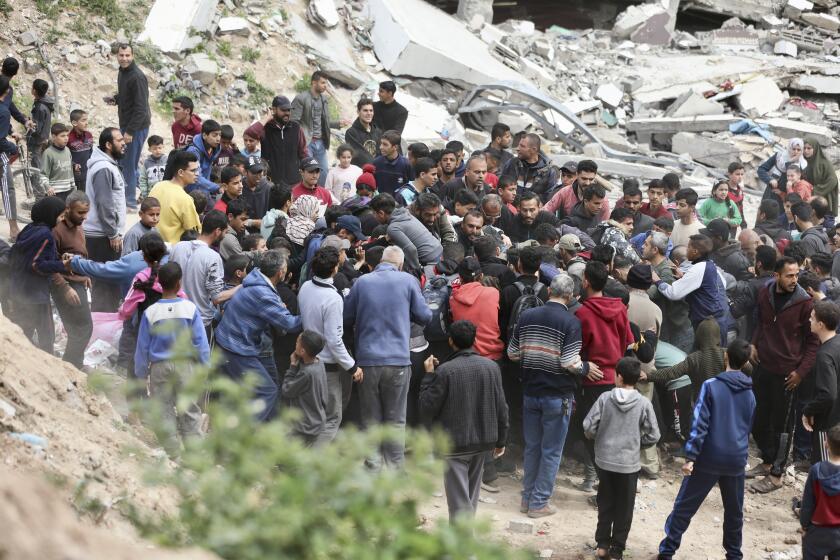How should we read the texts of Purim and Passover this year?

- Share via
In a few days, Jews will gather for the holiday of Purim and read aloud the Book of Esther. A month later, another gathering, another book — the Passover Haggadah. These ancient texts speak to us across the centuries, a conversation at once enlightening and fitful, bringing the past into the present in ways that are soothing but also discomforting.
This year, I feel the discomfort acutely. Since Hamas launched its horrific massacre and hostage-taking on Oct. 7 and Israel retaliated in a brutal, ongoing war, the texts appear both prescient and agonizing, troubling as never before.
The Book of Esther and the Haggadah were written in response to trauma, which may have been historical or may have been mythical, but ultimately the difference between historicity and mythology doesn’t matter here. Centuries of interpretation invite us to read the texts’ words and the lessons through the lens of our own experiences and sensibilities — much the same way most Americans read the U.S. Constitution and other such foundational documents. We highlight what resonates for us, and deny or downplay the parts that make us cringe, but grappling with the text is very human. And very, very Jewish.
Israeli Prime Minister Benjamin Netanyahu is railing against international criticism of his government amid the devastating war with Hamas.
Purim falls on March 23 and 24 this year, when Jews memorialize what is generally regarded as a story of joyful triumph of good over evil. Esther, a beautiful maiden who hides her Jewish identity, becomes a favorite of a king and bravely uses her proximity to inform him that his henchman, Haman, wants to destroy her people. Coached by her uncle Mordechai, Esther prevails and Haman is destroyed instead of the Jews. This is a rare diasporic biblical text — the events take place in Persia (outside the Holy Land) — and it features a woman as the savior of an oppressed minority, able to summon the courage to move from powerlessness to power. God is not mentioned once in the Book of Esther; it is a story driven by human agency.
It resonates today in the heartbreaking aftermath of the Oct. 7 attack. If only an Esther could have prevented the massacre and kidnapping. If only an enlightened monarch could have stopped the rape and slaughter. Haman. Hitler. Hamas. All creepily entwined.
But as we relate to the victimhood, we need to also acknowledge and relate to the revenge taken by the Jews. The ninth chapter of the Book of Esther, often read quickly as if an afterthought, details a violent episode of state-sanctioned retaliation, when Jews murdered 75,000 Persian “enemies” including women and children, and rejoiced afterward.
Not only was Haman executed, but at the request of Esther and with the acquiescence of the king, so were his ten sons. The text says that many Persians were so fearful of the newly militarized Jews that they professed to be Jews, too.
Israel is holding hundreds of Palestinians from Gaza who allegedly took part in the Oct. 7 attack that sparked its war with Hamas
For centuries, rabbis and scholars have tried to justify this problematic spasm of violence. Maybe the death toll wasn’t 75,000. Maybe women and children weren’t killed — even though that was explicitly permitted. Maybe all this was necessary self-defense.
I find these rationalizations unsatisfying. The ninth chapter reads to me like a warning of the extremes a formerly oppressed people will go to when given a rare opportunity to exercise political and military might. It uncomfortably echoes the Israeli assault on Gaza today, with entire families obliterated, hunger and displacement rampant, thousands of children killed and orphaned, and cities all but destroyed. Does one trauma justify another? When does self-defense bleed into revenge? How is proportionality weighed during what is today an existential crisis for Israelis and Palestinians?
There is a similarly uncomfortable section of the Passover Haggadah, read each year at the Seder table. Its placement in the second half of the Haggadah — after the matzo ball soup, brisket and macaroons have been happily consumed — means that many Jews just skip it. But those who take the text seriously must grapple with the shfokh hamatkha, a prayer that asks God to “pour out your wrath” against Israel’s enemies. Whereas the vengeance sought at Purim is committed by humans, this prayer begs for divine retribution — more abstract and yet more potent — and it appears after the part of the Passover story where the Israelite slaves have been freed.
For centuries, Jews have been bothered by the shfokh hamatkha, so much so that an alternative wording (“pour out your love”) appears in some versions of the Haggadah. But just like the ninth chapter of Esther, this text gives voice to a malevolence in the Jewish tradition that makes me wince, spotlighting an unfortunate feature of human behavior, inviting us even today to beseech God to pursue and destroy our enemies.
And yet, as my friend Rabbi Richard Hirsh tells me, “Removing nasty things doesn’t make the emotional impulses behind them go away. It just avoids them. The larger issue is, what do we do with the ugly stuff in our tradition? And not just our tradition. Is it better to read it, contextualize it, debate it? Or sidestep it and hope that nobody notices?”
Earlier in the Haggadah, there is the another disturbing account, drawn from the biblical book of Exodus, of the ten plagues God directed onto the Egyptians as a show of force to persuade the pharaoh to free the Israelites. But as the plagues are recited, a smidgen of wine is spilled for each one.
What I was always taught, what I believe today, is that we reduce our wine to diminish our own joy because of the suffering experienced by innocent Egyptians as God’s punishment reaches a crescendo, before the pharaoh finally lets the people go.
This admonition to recognize the pain and destruction visited upon one’s enemies and to temper our own sense of vindication is instructive, important — and even comforting. It demonstrates how these foundational texts give voice to our urge for vengeance and also provide a road map for empathy. In this, they are not simply stories from the past but necessary lessons for today.
Jane Eisner is the former editor in chief of the Forward, a national Jewish news outlet, and the former director of academic affairs at Columbia Journalism School. She is at work on a biography of Carole King.
More to Read
A cure for the common opinion
Get thought-provoking perspectives with our weekly newsletter.
You may occasionally receive promotional content from the Los Angeles Times.











